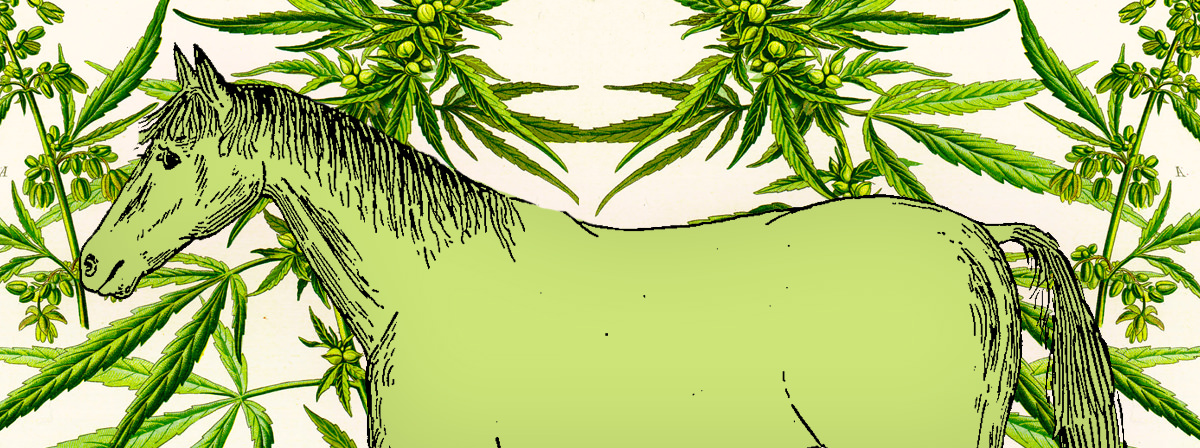
Veterinary medicine is currently at a crossroads with cannabis. Used since ancient Greek and Roman times as medicine for horses and cattle, now classified only as a toxin, a few voices are asking why we know so little about the beneficial effects of cannabis on animals.
Our knowledge has expanded exponentially since the passage of medical cannabis laws around the nation. Attitudes toward cannabis have crossed a threshold toward greater acceptance as more and more medical evidence is accumulated. The world of veterinary medicine is just now approaching that threshold.
Wesbites, such as PetPoisonHelpLine.com and ASPCA.org, list cannabis as toxic to dogs, cats and horses and focus on how to treat its ill effects. The most common patients seem to be dogs who have gobbled up someone’s stash or medibles and are dosed with much more than a therapeutic amount. While it’s definitely important to know how to treat the overuse of any substance; the absence of any information on the benefits of cannabis is a disservice to animals and their human companions.
Throughout my research, I came across only one case of death by cannabis — either human or animals — in an article titled, “Medical Cannabis: Is It Good for Our Dogs?” by Susan Tasaki, published on Bark.com. As the author points out, the baked goods in question contained both chocolate and raisins, both well known to be toxic to dogs. Interesting omissions in those other articles!
A groundbreaking article from June 15, 2013 published in the American Veterinary Medicine Association’s (AVMA) “JAVMA News” announced that a few vets are now joining the conversation about medical cannabis. Author R. Scott Nolen found two vets willing to challenge the pervading anti-cannabis bias among their colleagues, one of them anonymously. The named vet is Dr. Douglas Kramer, who “believes there is ample evidence to support using marijuana in veterinary patients…” Additionally, the anonymous vet confessed to being “frustrated by the predominant view among vets that marijuana is only a toxic plant.” Both asked for an increase in research. But as we know, it is quite the challenge to get authorization to study this federally illegal substance.
As of that article (the most recent info found), the AVMA took no position on medical cannabis while the American Holistic Veterinary Medicine Association officially encourages research. The situation is even more complicated with the pressure of cannabis legalization. An NBC TV 6 South Florida report called “Pot for Pets? Medical Marijuana in the Veterinary Field” stated that, “Marijuana occupies a strange set of honors in the halls of veterinary medicine. On the one hand, many veterinarians are desperate to study it. Reports from pet owners who have used it on their pets, combined with research being done in human medicine, relentlessly pique our curiosity. On the other hand, it holds the dubious honor of being one of the top reasons pets are rushed to emergency clinics! In fact, a 2012 study showed that over a five-year period in which marijuana restrictions loosened in Colorado, the number of marijuana toxicity cases increased fourfold throughout that state.”
Articles like “The Lowdown on Cannabis in Veterinary Medicine” by Dr. Heather Lewellan, and “Medical Cannabis: Is It Good for Our Dogs?” by Susan Tasaki, caution California vets interested in cannabis treatment that they are not covered by current medical cannabis legislation. This must serve to chill the curiosity of many vets. Coupled with the decades-long anti-cannabis bias prevalent in vet med schools and in official publications, it’s no wonder there is so little known about health benefits, outside of the historical record and anecdotal, though often powerful, stories.
We’re in a new world of old medicine. Old because evidence shows that the ancient Greeks and Romans used cannabis to treat horses and occasionally cattle, according to the report, “The History of Medical Cannabis Hemp Used to Treat Horses.” Some ancient recipes still exist for poultices (infusions or fresh leaves applied to the skin); seeds in a tapeworm remedy; infused oils used in colic recipes; even pulverized, dried leaves used for nosebleeds. Ancient writings suggested using cannabis as a sedative, for pain relief, and to counter tissue inflammation. Even the U.S. Cavalry carried tincture of cannabis in their field first aid kits.
 This same article recounts a most moving story of a woman who successfully treated her horse with cannabis. Her beautiful Paso Fino had such painful arthritis and degenerative ligament disease that she refused to stand, even on opioid drugs. But a cannabis infusion in her feed got her on her feet and able to walk.
This same article recounts a most moving story of a woman who successfully treated her horse with cannabis. Her beautiful Paso Fino had such painful arthritis and degenerative ligament disease that she refused to stand, even on opioid drugs. But a cannabis infusion in her feed got her on her feet and able to walk.
The trouble with veterinary uses is that there are no dosage standards and those standards will be different for different species. Clearly, dogs are super sensitive to THC. That anecdotal truth has some science behind it. Dogs have many more receptors for cannabis, making its effects more powerful. But, is that true for cats or horses or other animals? No one knows, yet. All we know so far is that all animals above insects on the tree of evolution have an endocannabinoid system, which gives them the potential to benefit from the plant’s various chemical compounds.
As Dr. Kupkee quoted in the NBC TV 6 South Florida report mentioned above, “One thing is certain… changing social attitudes regarding marijuana have created a demand for knowledge and access that vets can no longer afford to ignore. We can only hope that science and research will soon win the day, and provide the answers our profession and our clients are seeking.”
[useful_banner_manager banners=40 count=1]


Leave a Reply